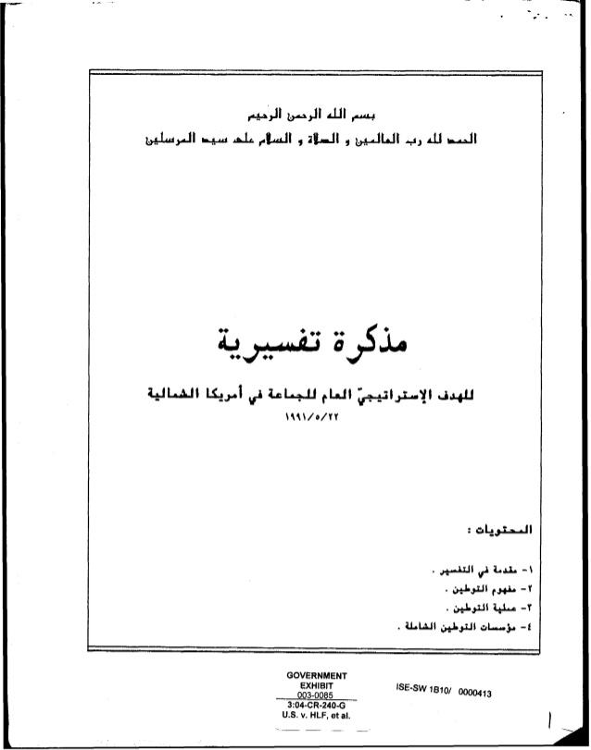Preface:
In the light of the severe blows the Middle East and North Africa suffered from the Muslim Brotherhood networks (MB) over the past decade the organization faces restrictions of its movement in the countries it shelters, such as Turkey. Furthermore, the organization is affected by government and security restrictions within a number of EU countries. Canada, geographically distant from the MENA region and from Europe stands out as one of the safe havens for the group that seems to exploit the climate of religious, political and social freedoms, as well as Canada’s place in the international economic and political system, to regroup in preparation for the stage of empowerment.
This study discusses the current reality of the Muslim Brotherhood in Canada, focusing on the most prominent institutions and organizations affiliated with the group.
Introduction
“The Muslim Brotherhood must understand that their work in America is a kind of great jihad to eliminate Western civilization, destroy it from inside and vandalize its miserable home with their own hands and the hands of believers until it is eliminated and the religion of God [Islam] triumphs over all other religions”.
This phrase appeared in a written document dated May 22, 1991 under the title “Explanatory Memorandum on the General Strategic Goal of the Muslim Brotherhood in North America” ([1]), and was submitted by a prominent leader of the group, Mohammed Akram, to the secretary of the Shura Council of the organization and the members of the council, as an explanation of what was stated in the long-term plan adopted by the Shura Council of the Muslim Brotherhood in North America in 1987. Additionally to that the organization planed and hosted an internal organizational conference held in the same year.

This internal document found in the home of Ismail Al – Barassi, a member of the organization (a Palestinian having the American citizenship) after his arrest in the US state of Virginia in 2004 on charges of joining Hamas, reveals that the International Organization of the Muslim Brotherhood has developed a plan for “empowerment” in North America ([2]), especially in the United States and Canada. Although the document caused a lot of controversy in political circles, the group, with its well-known “Taqiyya”, managed to evade charges of terrorism and fomenting unrest in the country, taking advantage of the climate of freedoms that allowed it to almost completely control the Islamic religious space in Canada, through an interconnected network of civil organizations, which the Brotherhood hides behind.
The presence of the group in the “country of maple” dates back to the middle of the twentieth century, where a number of its members travelled to the US to study at the universities, caused by the prosecution of the Egyptian authorities of the group’s cadres after the assassination attempt on President Gamal Abdel Nasser in what is known as the “Manshiyya incident” on October 26, 1954. The tensed political and security situation in Egypt led to the movement of hundreds of members of the Brotherhood to move to western countries where the diaspora had a strong footprint, especially Europe. From there, they began to establish their networks, which soon spread to northern America. As a result of starting to strengthen the organizations influence to America and to interconnect the networks, the Cultural Association was founded in 1962, the organization of Muslim students in 1963, the Islamic Society of North America in 1982 – 83, the Islamic Society of America in 1993 and dozens of other Islamic, social and “charitable” organizations and associations, which started to be more and more active within the US and Canada.
During the nineties of the last century, the movement of the Muslim Brotherhood within Canada increased. The organization managed to manifest this trend in establishing mosques, schools and cultural centers. In parallel, the group worked to expand and obtain popular and political support, using the most effective paper; guardianship of Muslim communities, whose members today are about one million Muslims ([3]), and monopolizing their representation before governments and the state.
The Muslim Brotherhood sought early to penetrate into Canadian society under various names and activities that are painted in the Islamic form. Their strategy was similar to what they did in Middle Eastern countries, where the organization usually follows a specific approach based on student activities. In Canada the organization started to penetrate the Muslim communities by forming and creating social platforms inside Canada and by starting to build up a force that can be exploited and bet on before successive governments. By making those social networks and connections stronger the organization was able to establish political advocacy organizations and worked intensively to co-opt and approach some circles of government and decision-making in order to achieve gains and protect the interests of the Brotherhood in the country.
Despite the multiplicity of Muslim Brotherhood activities and their diversity to include various aspects of life, the central administration of the group hides behind many names and proxies on the Canadian territory, most likely caused by the fear of security prosecution against the background of financing and supporting groups classified as terrorist. This is what happened when the “Irfan charity foundation” put one of the arms of the Brotherhoods network in Canada on the lists of terrorist organizations in 2014 because it financed Hamas. ([4]) This fear could also be triggered by the group’s approach in the Arab world, which is often based on secrecy, to get blackmailed and prosecuted in their home-countries for having connections to the Muslim Brotherhood networks in Canada.
Another point worth noting is that the organization often sees Canada and the USA as an integrated area for operations. Most of the Canadian Muslim Brotherhood organizations are associated with organizations in the US, and many personalities of the organization, who have the Canadian citizenship work or served for the organization in the US and vice versa.
[1] https://www.investigativeproject.org/documents/misc/20.pdf
[2] https://al-ain.com/article/brotherhood-canada-terrorism-saudi-arabia
[3] https://www.cicnews.com/2022/07/how-muslims-in-canada-are-celebrating-eid-ul-adha-0728533.html
[4] https://www.canada.ca/en/news/archive/2014/04/government-canada-lists-irfan-canada-terrorist-entity.html
All publishing rights and copyrights reserved to MENA Research and Study Center.

























